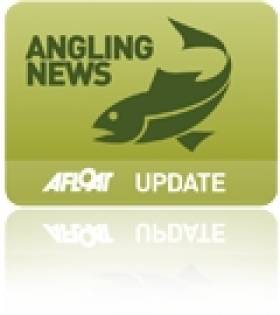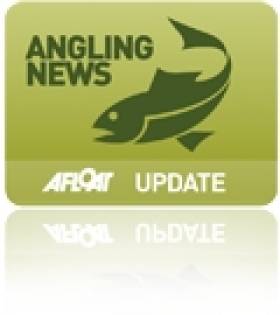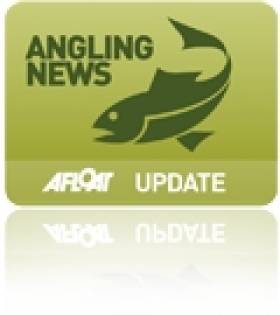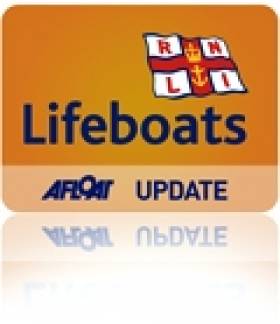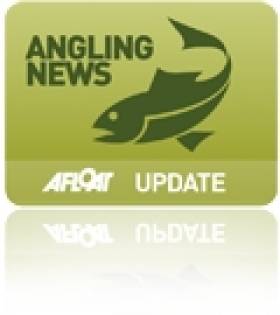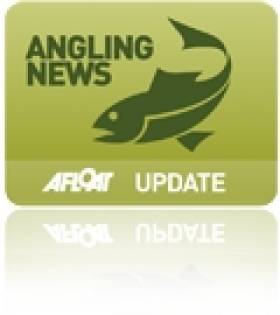Displaying items by tag: angling
Minister Hails IFI's Action Against Illegal Fishing
#Angling - Minister of State Fergus O'Dowd discussed some of the measures being employed to curb illegal fishing at a conference on wildlife crime at the weekend.
Addressing the Irish Wildlife Crime Conference in Ashbourne, Co Meath on Saturday 14 September, the minister highlighted the example of Inland Fisheries Ireland (IFI) and its work in tackling illegal activity in the fisheries sector - following news that angling is worth some three quarters of a billion euro to the Irish economy annually.
"IFI is bringing the fight to the poachers," he said, noting that 28,613 man hours were expended on lake patrols, 17,253 man hours were expended on coastal and estuarine patrols and 115,498 man hours were expended on river patrols in 2012 alone.
"But staff are not just going out randomly on patrol and hoping for the best, they are using all manner and means of equipment to target specific areas and increase efficiency.
"For example, fisheries officers are now using bicycles to access areas quickly such as many river banks. Kayaks are being used to conduct silent patrols along rivers and access areas which previously would have been almost impossible to get into unnoticed.
"Quad bikes are being used on some of the countries beaches to patrol for illegal bass fishing. Personal water craft and kayaks are being used to patrol shallow estuarine areas which previously would have been inaccessible to RIBS."
Fisheries patrols, the minister explained, have also had "significant success in the use of night vision scopes, thermal imaging equipment and covert cameras.
"Night time kayak patrols are now being conducted in pitch darkness with thermal imaging equipment along some of the countries largest river systems, and they have significantly aided in the detection of riverine nets.
"But arguably some of the best successes have come for the use of covert cameras. These cameras are covertly located overlooking a known poaching hotspot, the advantage is that they can use infrared light and operate in pitch darkness and they take an image of the subject and text it to the Fisheries Officer. So we now have a situation where the fisheries officer can actively patrol one area and remotely cover a number of other locations at the same time."
The use of cameras, he said, has resulted in a sting operation against criminal gangs poaching a particular fishing hotspot in the north-west.
"However, with all of this innovation there are still people who just do not care," he lamented, noting that in 2012 IFI seized over 24.5km of illegal net.
The only solution, the minister said, is ensuring that all actions against poaching "are underpinned by modern, sound legislation".
He continued: "The ethos of this new Fisheries Act is to make it easy to ‘do the right thing’ provide for administrative sanctions for those who unintentionally do the wrong thing, and save all of the big guns for the people who knowingly go out there to commit a fisheries crime.
"The experience of IFI is that the majority of anglers want to go out fishing, have a reasonable prospect of catching a fish, have a good day and broadly stay within the law – so with this Act we must make it easy to do this.
"Unfortunately there is a ‘rump’ of people out there who for whatever reason, would take the last salmon from a river with a net, for their own purpose. These I would postulate, are the same kind of people who would shoot deer illegally or engage in other types of wildlife crime."
Storm Slows Search For Missing Portrush Sea Angler
#Missing - The Irish Times reports that the search for a sea angler missing off the North Antrim coast has been postponed due to today's dangerously high winds.
The PSNI has also urged members of the public wishing to help with the search for the 38-year-old - who is believed to have been swept into the sea while fishing on rocks at Ramore Head yesterday - to step back and leave the search to the professionals.
“Deteriorating weather and sea conditions mean that the search environment is extremely challenging and police do not want to see anyone put at risk," said a spokesperson.
Tickets On Sale For Fourth Annual Irish Fly Fair
#Angling - The fourth annual Irish Fly Fair promises to bring together a host of the world's greatest fly-dressers, casters and angling celebrities to the Galway Bay Hotel in Salthill on 9 and 10 November 2013.
Like last year's successful event and the two years before, the two-day event will give visitors the chance to watch some of the best international fly-dressers practise their art, while champion fly-casters will be on hand to demonstrate their casting techniques and winning fly-fishing tactics.
Returning celebrity experts include Hywel Morgan, Glenda Powell and Peter O'Reilly, who will be joined by angling guru Charles Jardine among many others.
As per usual there will be a series of talks and seminars from the experts on a wide range of angling-related topics.
And that's not to mention the top quality trade stands with many a bargain to be had.
Tickets are available now priced at €10 for a day ticket (€5 for children) with weekend tickets also available from the Irish Fly Fair website HERE.
European Anglers Call For Tighter Controls On Salmon Farms
#Angling - A resolution passed last week at the general assembly of the European Anglers Alliance (EAA), representing the interests of 3 million recreational anglers across 13 European nations, demands that all farmed Atlantic salmon should be produced in closed or contained farm systems.
The EAA also urges all fish farming nations across Europe to pursue rapid development towards sustainability to reduce the impact on wild salmon populations, and urges policy makers to use the 'precautionary principle' and 'polluter pays principle' to ease the transition towards more environmentally friendly and sustainable salmon farming practices.
According to the lobby group, escaped farmed salmon and sea lice infestations continue to have a devastating impact on wild Atlantic salmon and Europe’s sea trout populations – many of which have seen severe declines, or have been destroyed completely.
So far the focus has been to fish-out escaped farmed salmon, as well as using chemical and biological measures to remove lice in the farms - measures that have unfortunately not solved the problems.
The alliance argues that closed or contained systems, either at sea or on land, would reduce the infestation of sea lice among farmed fish, reduce the risk of farmed fish escaping into the environment and dramatically reduce the damage done by waste, pollutants and chemical residues from disease treatment entering the natural environment.
“It may come as a surprise to most people that in many rivers there are more farmed than wild salmon," said EAA secretary general Jan Kappel. "The escaped farmed fish compete with and genetically pollute our wild salmon stocks. It is well known that sea lice spread from the salmon farms and harm wild salmon stocks.
"To our greatest surprise Norway has banned recreational angling in the Hardangerfjord where salmon stocks have declined due to the impact from extensive salmon farming. This doesn’t make sense. The polluter should be managed before other legitimate and sustainable users like recreational anglers are denied access to what used to be healthy salmon stocks.”
The EAA's comes in the wake of continued controversy over the proposed Galway Bay organic salmon farm, which if green-lighted would be the largest aquaculture facility of its kind in Europe.
Lough Melvin Crowns Four-Time Open Trout Champ
#Angling - In Friday's Irish Times, Derek Evans reports from the Lough Melvin Open Trout Angling Championship last weekend, where Brian Uprichard took the title for the second year in a row, and the fourth time in total.
The Co Down angler teamed with fellow former champion Cecil Marshall from Sligo to qualify for the final with a four-fish haul, then seal the championship with "five good fish" - topping a field of nearly 300 anglers from throughout Ireland and beyond.
"On this my first visit to Garrison and Lough Melvin, I was taken aback by the warm welcome I received and the camaraderie among anglers both on and off the water," writes Evans. "The new clubhouse, officially opened earlier this year, meets all present-day requirements and is testimony to a hard-working committee."
As reported earlier this year on Afloat.ie, the Fermanagh lake has been bucking the trend of declining fish stocks in Northern Ireland's inland waterways, with a salmon surplus that can only add to the sport.
Elsewhere, Carrickmacross anglers had reason to celebrate at the recent NCFFI All-Ireland Angling Championships in Cavan.
As the Dundalk Democrat reports, members of the Carrickmacross Coarse Angling and Junior Development Club placed first and third in the senior competition of the junior angling event.
Jamie Edwards landed an impressive 9.9kg for his number-one spot while clubmate Lee Harris landed 7.12kg.
And in the women's competition, Carrick's Emma McMahon topped the scales with her catch.
Improving Life for Trout and Salmon on Lough Corrib’s Tributaries
#Angling - A recent collaboration between Inland Fisheries Ireland (IFI), angling clubs and private individuals with close links to Lough Corrib is helping to improve matters for trout and salmon stocks in the catchment area.
Over recent years, State funding has been decreasing for habitat improvement and stream rehabilitation work on salmonid spawning and nursery streams. Local angling clubs and concerned individuals have recognised this, and stepped in to assist with funding to ensure this vital work on such a crucial natural resource continues.
A joint initiative between Cairde Loch Coiribe and the Clydagh Foundation has sponsored spawning and nursery rehabilitation projects on a number of Corrib streams.
Cairde Loch Coiribe raises funds from various angling clubs around the lake through the Corrib Federation, while the Clydagh Foundation invests in enhancement projects on the Corrib spawning streams. IFI staff, who have years of expertise in this area, design and supervise the projects.
This important work enhances habitat for spawning adult trout and salmon, and increases the nursery ground available for young fish to grow and mature.
Electro-fishing surveys carried out by IFI before and after similar works have shown that juvenile fish stocks can be increased significantly by such enhancement. It is hoped that these juvenile fish will eventually grow and augment the stocks of fish available for game angling.
Local clubs including Kilbeg, Ballindiff, Headford and Collinamuck have assisted in the most recent projects in their respective areas. Enhancement projects for 2013 have been identified and it is hoped to commence in the coming months.
These projects complement ongoing works by the OPW’s Drainage Division, under its Environmental River Enhancement Programme. This programme is carried out through liaison with IFI to improve fish habitat on previously drained channels.
Tourism angling is a major part of the local economy around Lough Corrib, and it is expected that this work will have tangible economic benefits.
Crosshaven Lifeboat Aids Angler at Sea
#rnli – A teenager became very unwell this evening whilst on an angling trip to the Ling Rocks on the south coast.
The skipper of the angling boat became concerned as her condition deteriorated and asked Valentia Coast Guard for assistance.
The volunteers of Crosshaven lifeboat were paged at 5.33 pm and were underway at 5.40pm. The crew of Vincent Fleming with Ian O'Keefe and Warren Forbes were on scene 20 minutes later and assesed the casualty whilst in communication with the lifeboat Doctor, Dr john Murphy.
It was decided to get the casualty ashore as quickly as possible and the lifeboat headed to Roberts Cove and was met by the lifeboat Doctor and the ambulance service.
After assesment the casualty was transferred to Hospital.
€50K Funding For Midlands Angling Clubs
#Angling - Angling clubs and community development groups in the Midlands Fishery Group Permit Area will share funding of €50,000 this year to carry out sustainable fishery development projects.
The Midland Fisheries Fund (MFF) was created by Inland Fisheries Ireland (IFI) from angler contributions set aside from the permit income received by IFI in the Midlands Fisheries Group permit area.
This year, funding will be awarded to eight sustainable angling development projects ranging from the development of access for anglers with disabilities to river rehabilitation and provision of shallow water marker buoys on midlands waterways.
IFI said it was thrilled at the great response received to this, the pilot year of the MFF. A wide range of fishery projects were applied for and the top eight proposals will share the available funding of €50,000.
Among the successful applicants were Lough Owel Trout Preservation Association, Kilconnell Community Development Association Ltd, Inny Anglers Development Association, Lough Sheelin Trout Protection Association, Ballinlough and District Angling Club, Pallas Lake Fly Fishing Club and Lough Derravarragh Angling Association.
The MFF is exclusive to the Midland Fisheries Group area and is only open to clubs in that area. This scheme, which is similar in design to the Salmon Conservation Fund, will allow for habitat improvement but importantly also includes angling development projects.
The successful applicants will be provided with technical assistance to help their projects become a reality.
"This fund reaffirms IFI’s objective to facilitate stakeholders to undertake sustainable development works," said Fergus O’Dowd, Minister of State with responsibility for Natural Resources. "These works will enhance and improve fisheries habitats and angling tourism potential and the contribution the inland fisheries resource makes to the economy.
"This scheme encapsulates the partnership approach between IFI and its stakeholders, ensuring projects are environmentally sustainable, undertaken with the appropriate permissions and guidance and developed by local angling clubs for the benefit of locals and tourists alike."
IFI chief Ciaran Byrne added: "It was clear from the large number of applications we received that anglers in the Midland Fisheries Permit Area are very keen to invest these funds, created from angler contributions, back into these fisheries.
"I’m very happy with the wide range of successful projects this year and wish the clubs all the best with their development work."
#Angling - The Galway Independent shines the spotlight on 15-year-old Ciarán Reilly, vice-captain of the cross-border Irish junior angling team headed to Wales nest week for the Home Counties International.
The Loughrea lad has already been selected as captain of next year's under-18 squad, but isn't looking past the stiff competition from across the UK at Llyn Brenig reservoir in North Wales on 7 August.
“I’d be fairly confident with the team this year,” he said with some understatement.
#Angling - Almost one in every 10 people in Northern Ireland went fishing in the last 12 months - but 70% of NI residents said they had no interest in the sport.
These statistics were among the key findings in a new report on attitudes to angling by adults in Northern Ireland, using data from the Northern Ireland Omnibus Survey conducted this past April.
As the Belfast Telegraph reports, among the other findings were that almost a fifth of the population used to go fishing but no longer so do, while some 4% of the populace have never fished before and would like to try.
Most respondents cited their lack of interest in putting them off angling as a pastime, while 19% said they did not have enough free time.
But 12% said better information on how to fish would encourage them to take out a rod and reel.
The Belfast Telegraph has more on the story HERE.

